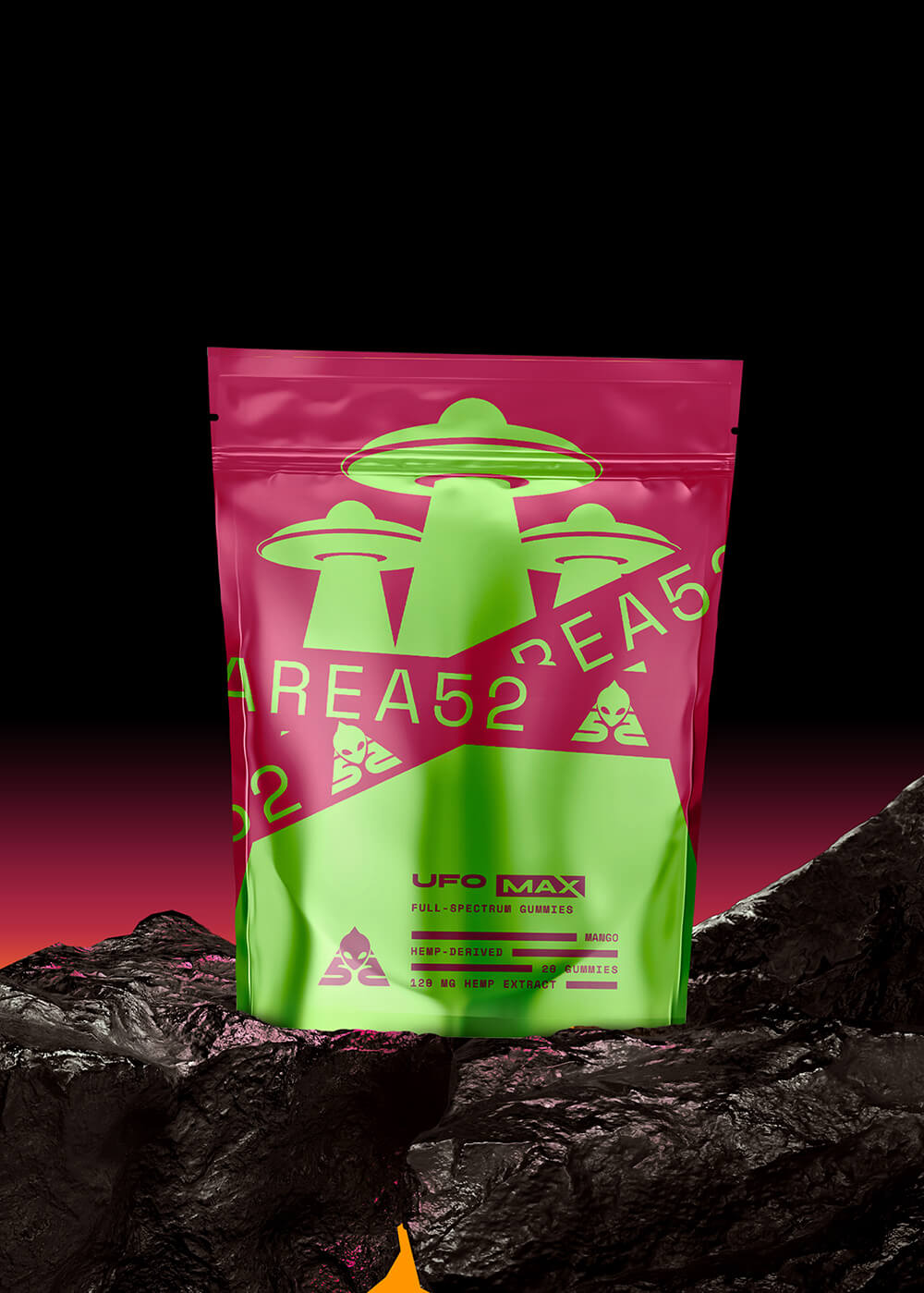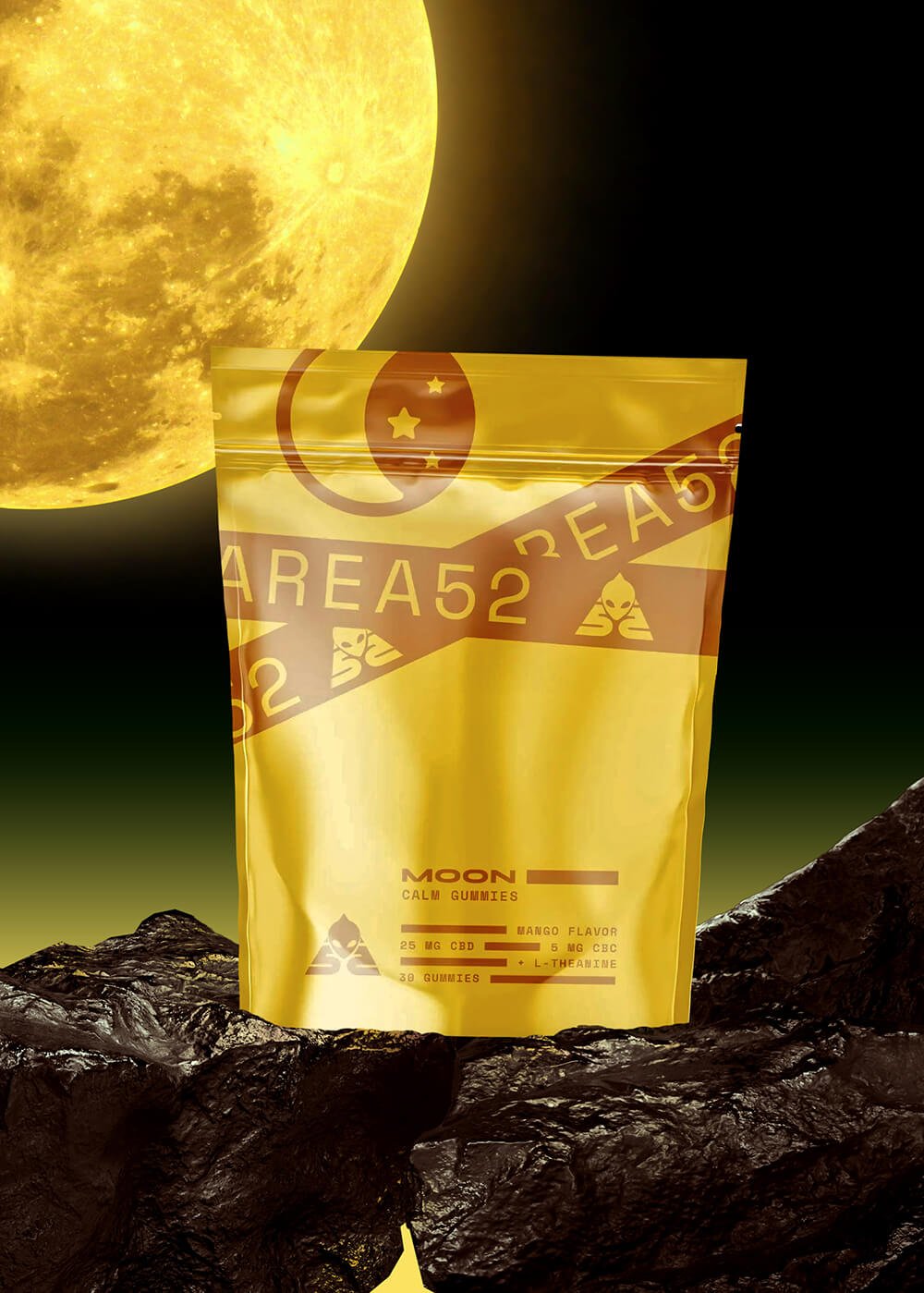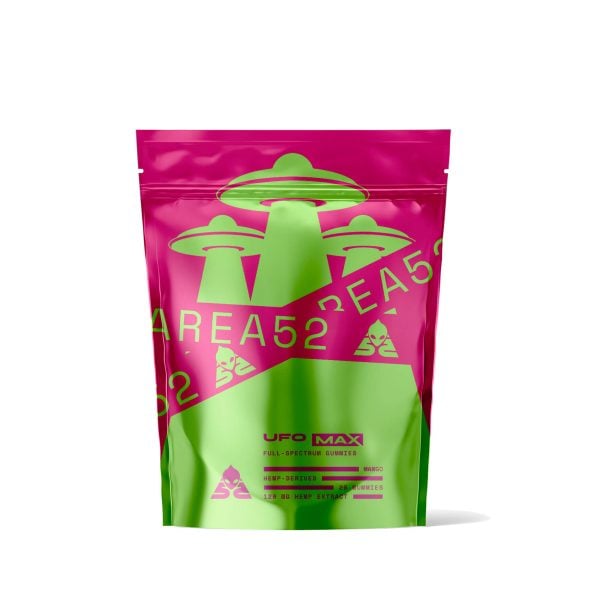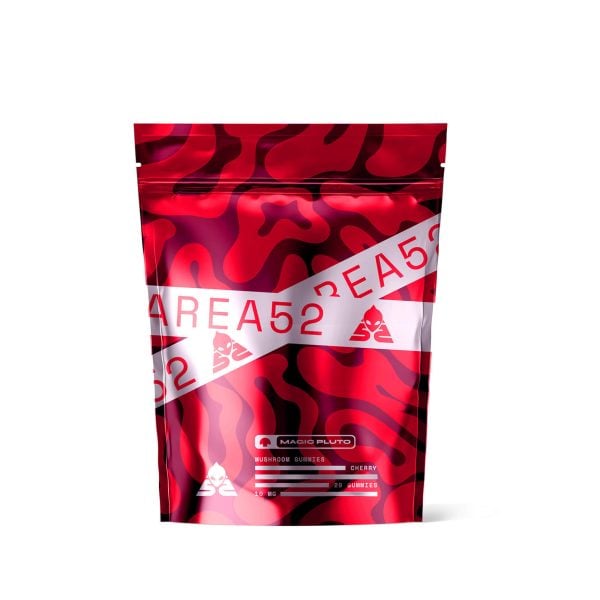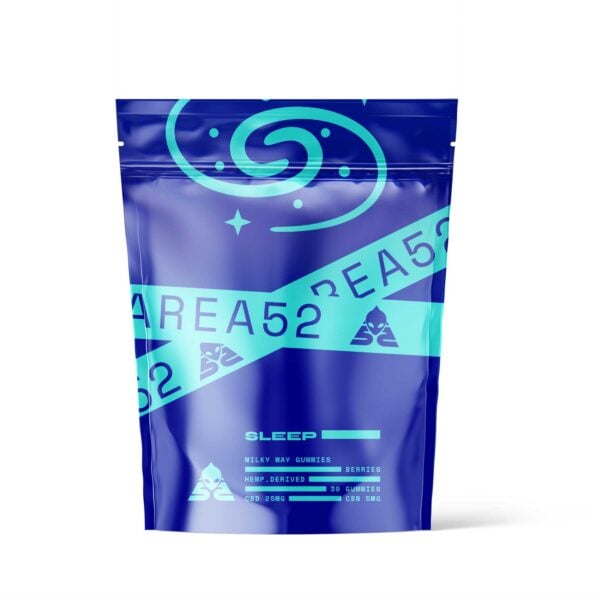How Much THC Is In Marijuana?
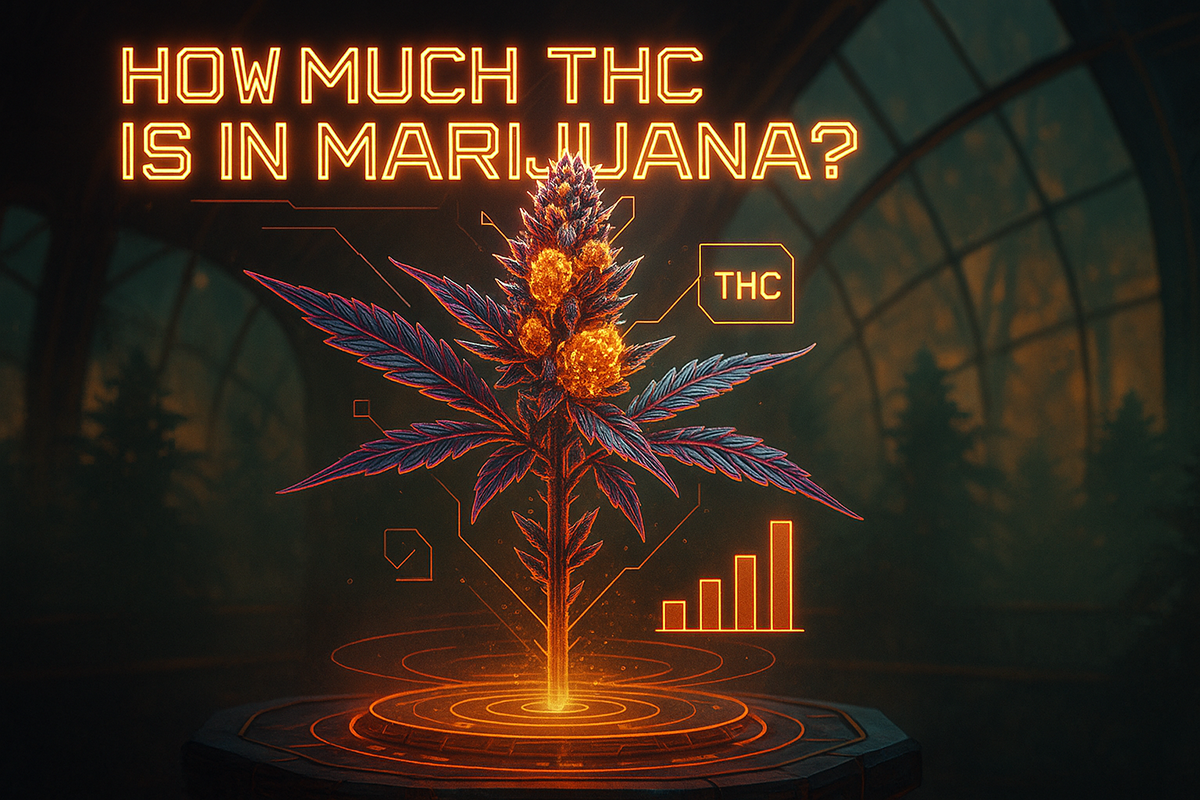
Have you ever wondered how much THC is in weed? THC potency in cannabis can be anywhere from near 0% in hemp-derived products to 90+ percent in cannabis-derived products such as marijuana concentrates.
The average THC content or potency isn’t static, either. Various factors affect THC levels, from seed up until the moment you light up. Figuring out the amount of THC often requires a bit more effort than just reading the label.
In this guide, we’ll cover the various types of THC present in marijuana, how you can calculate THC content, and to what extent THC content determines cannabis’ potency.
How Much THC Is In Marijuana?
The amount of THC in cannabis varies substantially between different strains and products. It even varies across time.
When THC potency was first accurately measured in the 1960s, content in many strains hovered at around 4-5%. These figures may be a little deflated, though, as testing and storage methods used back then often degraded the cannabis samples analyzed.
Still, there’s little doubt that THC content in most strains grown today is significantly higher than in decades past. As more states legalize recreational cannabis, more breeders are experimenting with new strains and competing to produce the most potent flower.
The federal government’s Drug Enforcement Administration (DEA) reports that the average percentage of THC potency of the marijuana seized in 2018 was around 15%. Now, it’s common to find cannabis flower in state-legal dispensaries with more than 20% THC. One popular strain, Godfather OG, has as much as 34%.
The range of THC content increases further depending on the product. Aside from flower, consumers can also buy marijuana edibles, tinctures, topicals, and concentrates.
Cannabis concentrates are made by extracting the cannabinoid and terpenes from the flower and discarding any excess plant material. The resulting concentrate can contain at least 70% THC, but products with more than 90% THC are also available.
How Is THC Content Calculated?
The THC content of cannabis indicates its potency, so consumers need to know the percentage when making a purchase.
Most states with legalized marijuana require products to be tested for THC content (among other cannabinoids) and for this information to be displayed on the label.
However, since there aren’t industry-wide standards for cannabis product testing and labeling, this information on the label may vary from state to state and product to product.
In general, though, often under the heading “Potency Analysis,” the product label will include figures for THC, THCA (tetrahydrocannabinolic acid), and Total THC (as well as CBD, CBDA, and Total CBD).
Understanding the differences between these THC percentages is the first step toward understanding how THC content is calculated.
THC vs. THCA: What’s The Difference?
If you look at a cannabis product label, you’ll notice there’s much less THC in cannabis than there is THCA, which is a non-intoxicating cannabinoid. Marijuana flower may contain only 1-2% THC but more than 20% THCA.
THC is produced, or ‘activated,’ from THCA through decarboxylation, which basically means using heat to convert THCA into THC. This process also occurs naturally over time.
This is why ingesting raw cannabis flower won’t get you that high.
The THC content we’re most interested in is the amount present by weight in dry flower after decarboxylation since this largely determines its potency. This amount is what’s known as ‘total THC’ content.
On a cannabis product label, the total THC value is less than that of THCA. This seems counterintuitive since we might expect ‘total THC’ to simply be the sum of THC and THCA.
This isn’t the case, though, for two reasons.
First, THC is lighter than THCA. After converting, THC is 87.7 percent of the weight of THCA. In essence, THC is THCA with missing parts.
Second, decarboxylation isn’t completely efficient. THC conversion depends on various factors, such as temperature, exposure time, and the heating instrument used (an open flame or a vaporizer, for example). So, some THCA molecules won’t convert to THC, while exposure to a lot of heat will degrade THC into CBN.
THC Content: A Simple Equation for the Most Accurate Number
Determining the exact THC conversion efficiency is, therefore, quite difficult. Some marijuana testing labs estimate that around 75% of THCA will convert to THC, though this is an upper limit.
This means that to calculate THC content, first, take the weight difference between THC and THCA into account, then the inefficiency of the THC conversion process, before adding the amount of THC already present in the cannabis product.
The resulting equation looks like this:
(0.75 x 0.877 x %THCA) + %THC = Active and consumable THC content
For example, if you have a cannabis product with 20% THCA and 1% THC, this is what you would end up with:
(0.75 x 0.877 x %20THCA) + %1THC = 14.155% Active and consumable THC content
While still imprecise and a little complicated, this method is one of the most accurate ways to calculate active THC content in cannabis flower.
What Type of THC Is In Marijuana?

THC is often used as shorthand for delta 9 THC, but THC isn’t just one compound. It has multiple structural forms, known as chemical analogs.
Delta 9 THC is the most well-known, potent, and abundant THC analog in cannabis, but they all share similarities in one respect or another.
These small structural variances, however, result in very different physiological responses.
1. Delta 9 THC (THC)
THC’s psychoactive effects arise from the unique double bond structure on its molecular chain.
For delta 9 THC, the double bond is on the 9th carbon atom, and it binds to the CB1 receptor in the body’s endocannabinoid system (ECS).
Delta 9 also has a 5-term side alkyl chain, a series of five carbon atoms that enhance the compound’s effects on the body.
2. THCV (Tetrahydrocannabivarin)
The second most abundant type of THC in cannabis is Tetrahydrocannabivarin or THCV, yet it is one of the least well-known.
It’s produced as a byproduct of THCA’s decarboxylation and differs from delta 9 THC in having a 3-term side alkyl chain rather than a 5-term one.
This means THCV doesn’t bind as strongly to the body’s CB1 receptors, so its effects are less pronounced. However, this is only the case at low doses. At high doses, THCV’s psychoactive effects are comparable to delta 9.
3. THCC (Tetrahydrocannabiorcol)
THCC or Tetrahydrocannabiorcol is a non-psychoactive compound present in cannabis pollen. It’s most compatible to CBD in terms of effects.
Indeed, while THCC is an analog of THC, its effect profile bears more relation to that of CBD.
THCC doesn’t bind well to either the CB1 or CB2 receptors but is unique for its capacity to bind to the vanilloid receptors (TRPA1).
4. THCP (Tetrahydrocannabiphorol)
Tetrahydrocannabiphorol, known as THCP, was discovered in 2019 and differs from delta 9 THC in having two extra carbon atoms on its alkyl side chain.
In general, a longer side chain means more pronounced CB receptor activity. So, THCP’s psychoactive effects are stronger than delta 9’s, with some reports suggesting it may be as much as 33 times more potent.
THCP is the first naturally occurring cannabinoid found with more than five carbon atoms on its alkyl chain, though synthetic varieties of THC can contain more.
5. Delta 7 THC
Though delta 7 THC was first synthesized during the 1940s, research into it has been extremely limited.
Delta 7’s double bond is on the seventh carbon atom, and it’s thought to be significantly less potent than delta 9, but even this isn’t certain.
6. Delta 8 THC
Following the delta numeric pattern, delta 8’s double bond is on the eighth carbon atom.
For these reasons, delta 8 has become extremely popular among consumers in recent years, even though it’s only present in cannabis in very small quantities. As such, it must be extracted and distilled from hemp-derived CBD through a complicated process.
7. Delta 10 THC
Delta 10 THC is also present in very small quantities in cannabis, and its double bond is, unsurprisingly, located on the tenth carbon atom.
The similarities with delta 8 don’t end there. When you compare delta 10 THC to delta 9 THC, the former has less potent psychoactive effects than the latter.
What Factors Affect THC Content?
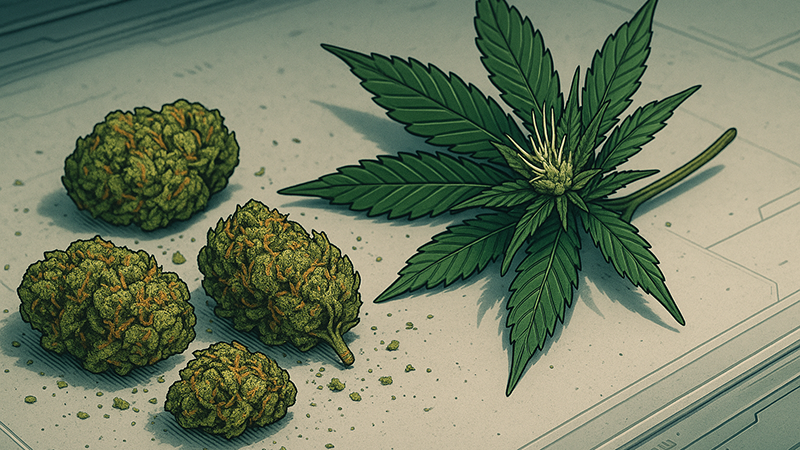
Numerous factors, such as genetic and environmental, affect the THC content of cannabis.
A) Genetics
The cannabis plant’s genetics is the first factor to consider that affects THC content.
Each strain has a unique genotype that acts as a blueprint for how it will grow and a unique phenotype that affects how the plant will respond to environmental conditions.
B) Other Enzymes
One of the more important genetic characteristics that affect THC content in a particular strain is certain enzymes’ presence (or absence), which determine the ratio of THC to CBD.
The more CBD there is in a particular strain, the less THC there will be. This is why cannabis strains are broadly referred to as CBD-dominant, THC-dominant, or balanced.
THC and CBD content are related since both are ultimately produced by the same cannabinoid called cannabigerol (CBG) from its acidic form – CBGA. A CBGA molecule can either turn into THCA (the precursor to THC) or CBDA (the precursor to CBD).
Which one it turns into depends on the presence of an enzyme that exists in two forms. The first converts CBGA into CBDA, the second converts CBGA into THCA.
Depending on their genetic code, some cannabis strains contain both forms of this enzyme; the rest have one or the other.
So, a cannabis strain that only has the enzyme form that converts CBGA to THCA will contain a lot more THC. This is the kind of strain that those growing marijuana for recreational dispensaries are interested in. A hemp farmer will look to strains with only the other enzyme form that activates CBD production.
C) Environment
Environmental factors also help determine THC content after the seed or clone has been planted. However, a study from Cornell University suggests environmental stresses may play a much less significant role in this regard than previously thought.
Nonetheless, as with any plant, environmental conditions largely determine how well it grows.
These environmental factors include the growing method used (indoor vs. outdoor, soil vs. hydroponic), nutrient availability, the source and spectrum of light, pH and CO2 levels, temperature, and humidity.
Suboptimal environmental conditions mean the cannabis plant will be under stress and prioritize its survival over the production of cannabinoids like THC.
Once the growing cycle is over, and the plant starts flowering, THC content continues to change in response to environmental conditions. This is why appropriate harvesting, processing, and storage practices are also important in determining THC content.
Does THC Content Matter?
So, we have an idea of how to calculate THC content and the factors that affect the amount of THC available. But does THC content matter?
While THC content indicates its potency, a larger THC content doesn’t necessarily produce a stronger high. Other factors like the person’s mental state and personality, along with other cannabinoids present, can alter the effects.
The presence of terpenes and other cannabinoids are other important factors that determine how potent the cannabis product is. This is a phenomenon that’s known as the ‘entourage effect.’
In particular, recent research indicates that THCP may play a hugely significant role in THC potency, which would explain why some strains have much stronger effects despite having comparable THC levels.
The exception to this is marijuana edibles and tinctures. One that contains 100 milligrams of THC will undoubtedly result in a stronger high than one with 50 milligrams of THC. So, using high-THC cannabis is more efficient when using these products.
What’s the Average Dose of THC?

An average dose of THC differs from individual to individual since everyone has different THC tolerance levels.
These differences are based on a multitude of factors, including age, weight, sex, prior cannabis use, the individual’s endocannabinoid system, and health.
In general, though, less than 10 mg of THC is considered a low dose, while a dose between 10 and 30 mg of THC would be strong for a beginner and have considerable effects even on someone who consumes cannabis regularly.
Doses above 30 mg of THC are very potent and should only really be consumed by experienced users.
How Much THC Is in a Joint?
So, if those are the average doses of THC for users with different tolerance levels, then how much THC is in a joint?
As discussed earlier, to calculate how much THC concentration is in a joint, there are three main factors to consider; the weight of flower used, the potency of the cannabis, and the amount of THC lost through combustion.
So, if a joint holds one gram (1000 mg) of cannabis flower with a THC content of 20%, then it contains 200 mg of THC.
If you smoke the whole thing, though, that doesn’t mean your body actually absorbs the full 200 mg. That wouldn’t be advisable in any case.
One 1990 study estimates that only 20-37% of the THC in a joint is inhaled. Around 23-30% is lost to pyrolysis (burning), while anywhere between 40-50% disappears from the smoldering end.
Using our example of a joint containing 200 mg of THC, this means only between 40-74 mg of THC would actually make it to your lungs.
Key Takeaways: How Much THC is in Marijuana?
There are many factors that affect the THC content in marijuana, and even then, the numbers aren’t constant. Everything from the environment the plant was grown in, to the number of terpenes and other cannabinoids, plus individual factors like tolerance and mental state, play a role in the amount of THC and how it affects you.
You can figure out the THC content with either a rough estimate or a more scientific formula, though if you’re really concerned, you’re probably better off going with edibles or a tincture.
FAQs on THC Content in Weed:
Want to know more about the THC level in the vast majority of products? Then check out the short list below.
1. Does High THC Get You High?
Yes. Even 5 mg of THC, which is pretty low for experienced users, can already get you high. But if you’re after the therapeutic potential and benefits of both THC and CBD as well as other cannabinoids, this low dose is oftentimes good enough to help ease discomfort and stress.
Do note though that even this low dose can already increase drug abuse risk and lead to negative health consequences and side effects such as dry mouth and dry eyes.
2. What is the THC Level of Strong Weed?
The average concentration of most cannabis strains in the cannabis industry ranges from 15% to 20% THC. However, potent strains like Godfather OG can have as high as 34% THC.
3. What Percent THC is in Street Weed?
The average THC of illicit dried cannabis flower or street weed is around 16%. However, this can vary depending on the strain, the growing method, and the flower quality.
4. Can Weed Be 70% THC?
It depends on the type of product. Flowers typically range from 15% to as high as 35%, while concentrates have higher levels of THC, ranging from as low as 60% to as high as 90%.
5. Is 90% THC Strong?
Yes, 90% of THC is strong, and so is any product containing more than 25 mg of THC. If you’re new to high-THC products, it’s recommended to start low and go slow.
References Used:
- Carlini, E. A. (2004). The good and the bad effects of (−) trans-delta-9-tetrahydrocannabinol (Δ9-THC) on humans. Toxicon, 44(4), 461-467.
- Abioye, A., Ayodele, O., Marinkovic, A., Patidar, R., Akinwekomi, A., & Sanyaolu, A. (2020). Δ9-Tetrahydrocannabivarin (THCV): a commentary on potential therapeutic benefit for the management of obesity and diabetes. Journal of Cannabis Research, 2(1), 1-6. [2]
- Andersson, D. A., Gentry, C., Alenmyr, L., Killander, D., Lewis, S. E., Andersson, A., … & Zygmunt, P. M. (2011). TRPA1 mediates spinal antinociception induced by acetaminophen and the cannabinoid Δ 9-tetrahydrocannabiorcol. Nature communications, 2(1), 1-11.
- Kruger, D. J., & Kruger, J. S. (2021). Consumer Experiences with Delta-8-THC: Medical Use, Pharmaceutical Substitution, and Comparisons with Delta-9-THC. Cannabis and Cannabinoid Research. [4]
- Kruger, D. J., & Kruger, J. S. (2021). Consumer Experiences with Delta-8-THC: Medical Use, Pharmaceutical Substitution, and Comparisons with Delta-9-THC. Cannabis and Cannabinoid Research.
- Ashton, H. E. A. T. H. E. R., Golding, J., Marsh, V. R., Millman, J. E., & Thompson, J. W. (1981). The seed and the soil: effect of dosage, personality, and starting state on the response to delta 9 tetrahydrocannabinol in man. British journal of clinical pharmacology, 12(5), 705-720.
- LaVigne, J. E., Hecksel, R., Keresztes, A., & Streicher, J. M. (2021). Cannabis sativa terpenes are cannabimimetic and selectively enhance cannabinoid activity. Scientific reports, 11(1), 1-15.[7]
- Citti, C., Linciano, P., Russo, F., Luongo, L., Iannotta, M., Maione, S., … & Cannazza, G. (2019). A novel phytocannabinoid isolated from Cannabis sativa L. with an in vivo cannabimimetic activity higher than Δ 9-tetrahydrocannabinol: Δ 9-Tetrahydrocannabiphorol. Scientific reports, 9(1), 1-13. [8]
